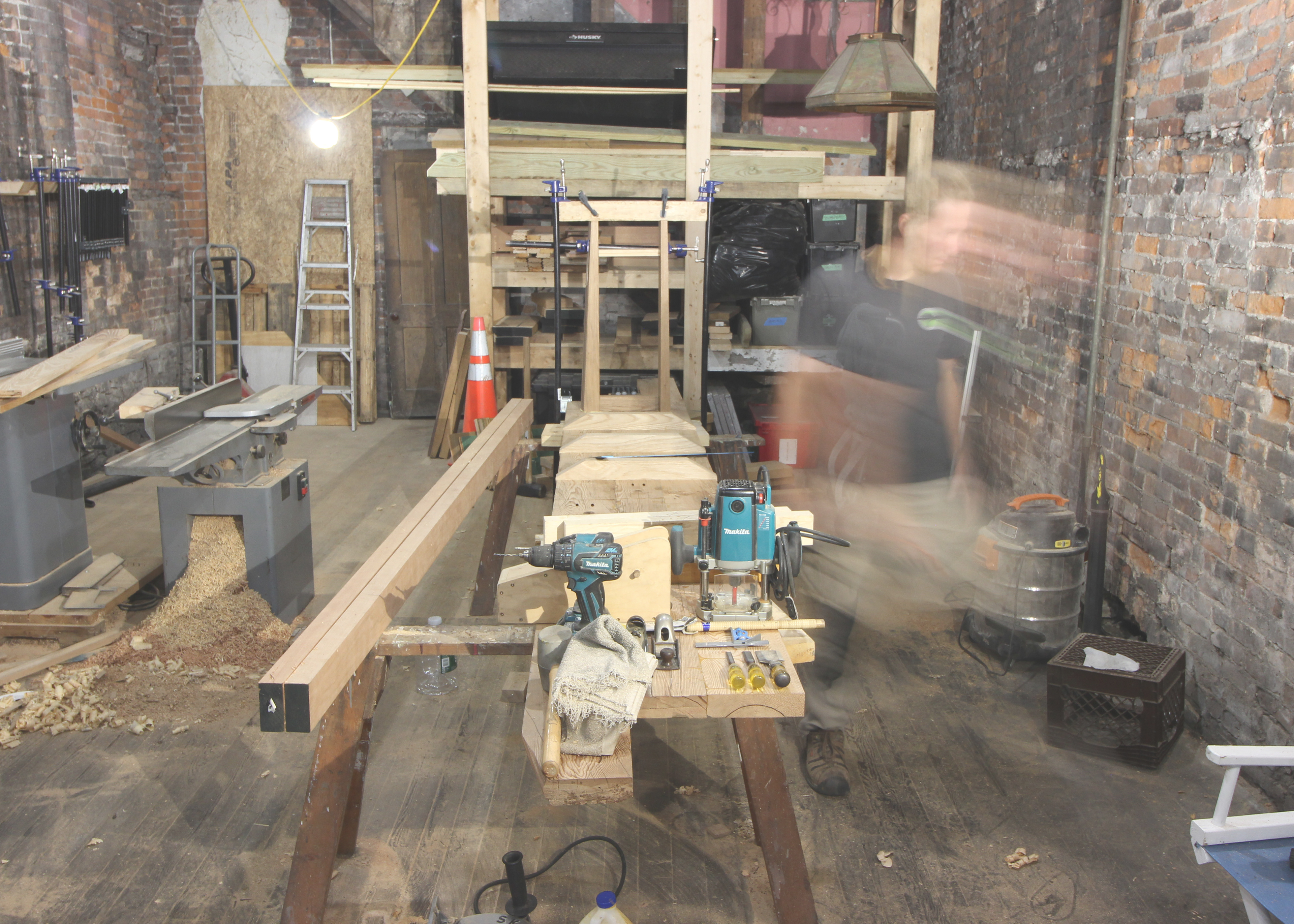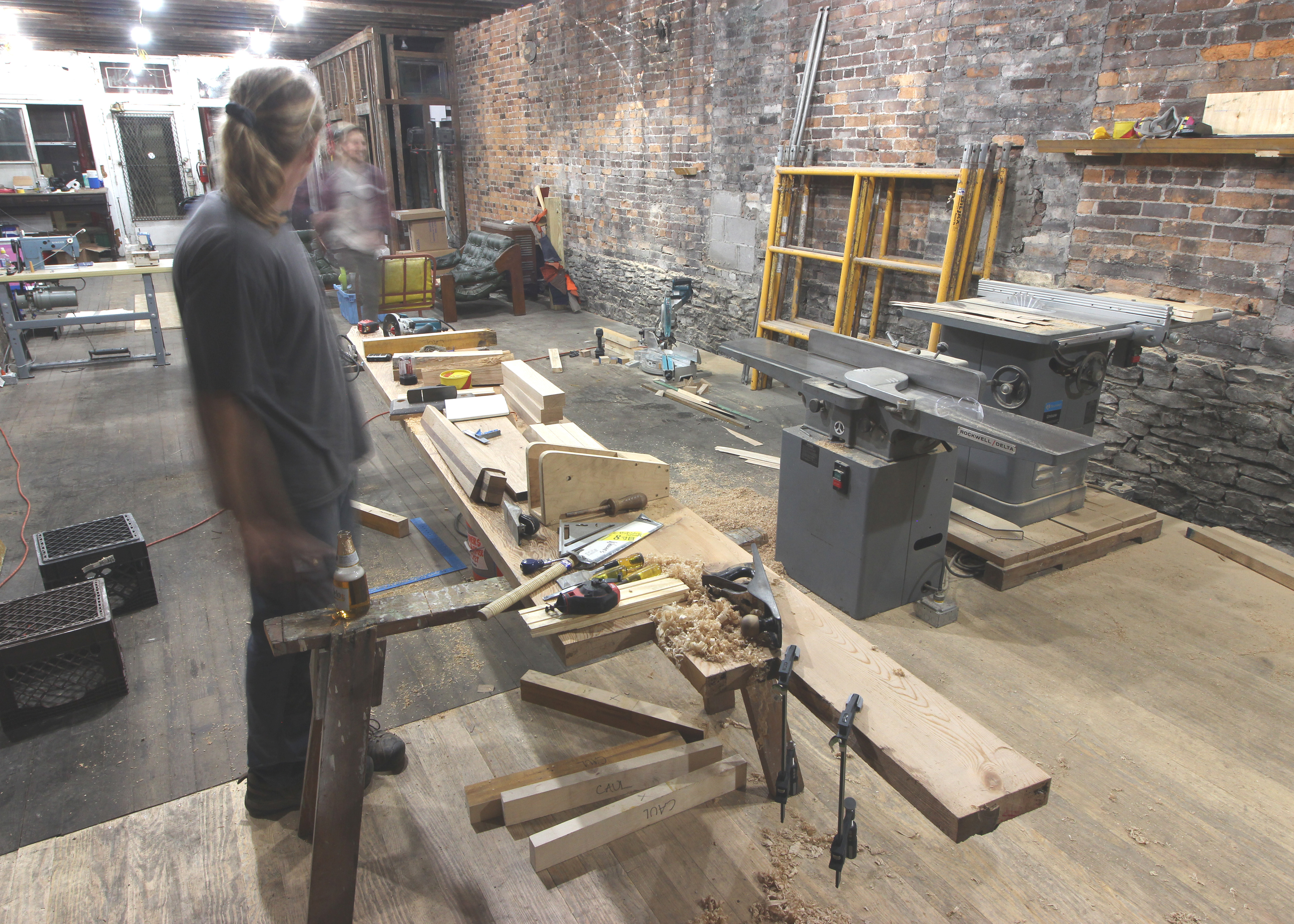This ideological force driving the creation of this table began out of a necessity for a functional work surface, but through serious contemplation and conversation it has become much more than that. While creating the table and simultaneously asking a question about creating societal shared values, the table became the centerpiece of communal discussion. Value was given to the table by its maker, me, and my understanding of its materials, the process, and my own ideological values. This value was then shared with others through a discussion about the table around the table, and through this discussion they began to see value in the table just as I did.
Through this process of serious discussion and making, our questions can be interrogated and our shared values can be discovered.
The initial vision was for a table that was long and narrow. Narrow to maintain floor space and long create a functional surface for assembling other projects.
The table top is made with the 170-year-old joists from the floor on which it stands. The repair of that floor involved the replacement of around 12 existing joists. From these 12, only three were solid enough to use in the table top. The rest suffered from severe rot. After being de-nailed, milled, and glued up; the joists presented me with a 12’ long 20-3/4” wide table top. It is important to note that these dimensions are a result of the choice to use the floor joists and the milling process alone.
In the beginning phases of this project I would have liked to get a fourth board from the joists, but the narrow width has made the table a more versatile surface for glue ups, and a more intimate surface for conversation. The offsetting of butt joints (for longitudinal strength) during the glue up created an interesting situation at one end of the table. That same offset distance is now reflected in one end of the table, and it is surprisingly functional for clamping and working various materials. This discovery through the process has given the table an asymmetrical form. To balance the asymmetry, I used tall skinny tapered legs at the stepped end, and a heavier base of shelves at the opposite end.
The legs at the stepped end of the table top are made from white oak and a small amount of black walnut, both materials which I had already possessed. The white oak was obtained at a liquidation sale of unusable cutoffs from a nearby lumber yard, and the black walnut came from a local tree which was felled a couple years prior. The black walnut tree was about six feet in diameter and it resided in Allentown, Buffalo, just North of Allen Street on Franklin. Its location and size led me to believe that is was one of the older trees in the city. I picked up some left overs the logging company deemed unusable and left as scrap. I then took them to the UB Fabrication Workshop and milled them myself.
My initial vision for these legs was to taper them along the length of a pentagonal section. To do this I began just as I would with any other project, squaring stock. I used the jointer to begin the squaring process, somewhere in the process of jointing the first board I got carried away and ended up with a board that changed from being one inch thick at one end to two inches thick at the other. Just before I decided to discard that piece and start another, I realized that I could use the jointer to replicate this accidental taper intentionally! This also made the overall process easier, because at the time I did not own all of the proper machinery to square up material. From then on, I began sculpting tapered legs with the jointer. The first leg was about 8” wide and 2” thick at the top and about 6” wide and 1” thick at the bottom. This process was thrilling, but I wanted a leg that was closer to the massing of a typical circular table leg. I continued to repeat the process, except this time I cut the doubly tapered leg in half just like one would split a rectangle into two triangles. When the triangular profiles were aligned it created a diagonal seam because of the taper along the thickness of the original rectangular piece. I decided to highlight that joint by separating the two white oak pieces with a thinner black walnut piece (which was also tapered). After the three layers were laminated, I began sculpting with the jointer again. The contrast between the two different species highlighted the tapering in very interesting ways, I found that if I removed enough material at an angle the black walnut would reveal itself in a very large triangular form. In the end I had leg which was about 5”x5” at the top and 2”x2” at the bottom all along a funky asymmetrical polygonal section. All of that said, I got lost in the process, and the result was something that I have never seen before. Because I used thrifted materials and had a lack of proper machinery, I achieved atypical results. Diversity in the workflow of both materials and methods, and my own personal value in the work achieved a unique and subjectively beautiful pair of table legs.
The legs at the square end of the table are made with white oak and wood from a door which was salvaged during the interior demolition of the building. The door was chosen because my initial vision for this end of the table was to have a cabinet like base with shelves. For the construction of this cabinet-like base with shelves, some sort of sheet material is typically required. Or something wider than a typical board of hardwood, in this case that happened to be a door. First the door was ripped to width which was suitable for the width of the table top, it needed to be wide enough to house the depth of a shelf and narrow enough to allow for clamping to the edge of the table top (its intended use). The door was ripped into two 12” wide halves, and cut to be around 36” long. These two pieces were covered in the paint from the original door that they were, some brown and some green. The initial attempt to remove the excess paint revealed a very diverse and somewhat monochromatic patina. Below the brown was green and below the green was beige. On the opposite side, below the green was a lighter green. Resulting from scrapping and flattening the surface of the two pieces was a well-balanced variety of earthy tones which I think compliment the natural wood finish of the table and some existing green paint seen throughout the space. The green must have been the previous building owner’s favorite color, because it can be seen throughout the four stories of the building on cabinets, doors, shelves, and other obscure objects. This color is an homage to what the space was before, a pawn shop from the 1960’s in a 19th century brick urban fabric building of what was once the bustling downtown Buffalo, New York. These two legs where capped at the top and bottom with white oak. At the top the white oak acts as a cross rail to prevent the top from warping over time, and at the bottom the white oak is wider than the legs themselves to act as feet and resist the tall tables urge to topple over.
The cross rails are made from white oak and can be seen 16” on center along the length of the table top. These rails are intended to correct the already cupped table top, and prevent it from happening in the future. They are about 2” wide and 3” tall along the width of the table top. Each end was tapered at 60 degrees to soften the edges to the touch, and relate to the form of the sculpted tapered legs at the stepped end of the table.
The sources of these materials, the processes of working them, and meanings they embody all contribute to the creation of a table which has become not only part of a studio workshop, but it has become a very important contribution to a collective conversation about shared values, and a symbol about the process of their discovery. It is the creation of objects like this, that will continue to aid in the search for meaning in the work of the craftsperson.
This ideological force driving the creation of this table began out of a necessity for a functional work surface, but through serious contemplation and conversation it has become much more than that. While creating the table and simultaneously asking a question about creating societal shared values, the table became the centerpiece of communal discussion. Value was given to the table by its maker, me, and my understanding of its materials, the process, and my own ideological values. This value was then shared with others through a discussion about the table around the table, and through this discussion they began to see value in the table just as I did.
Through this process of serious discussion and making, our questions can be interrogated and our shared values can be discovered.


